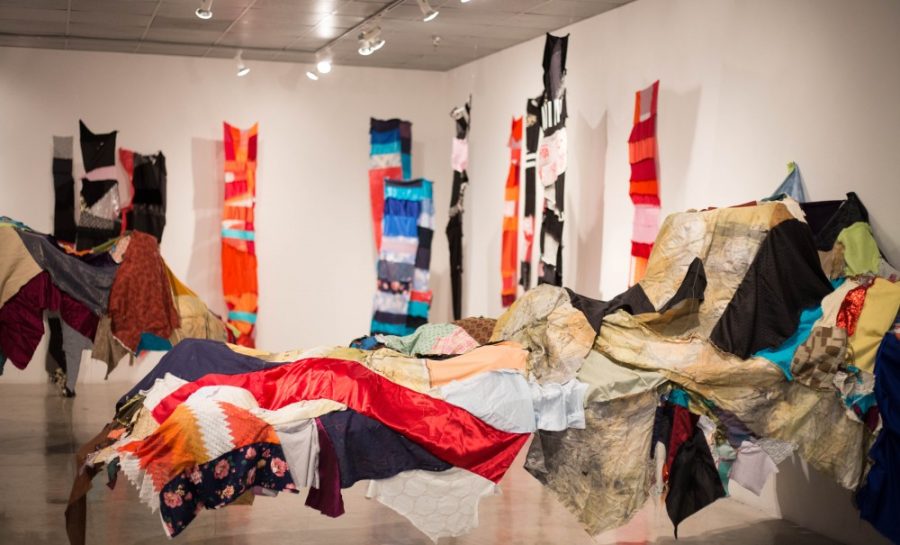Ashley Dahlke, a second-year graduate student in the University of Arizona’s School of Art, explores the connection between people and objects through her art installation, “The Space Between,” located in the Lionel Rombach Gallery.
Hoarding is the persistent difficulty in discarding, or parting, with possessions regardless of their actual value. Whether a person is defined as a compulsive hoarder or not, everyone feels connected to objects in some way.
This installation works to “engage with the subconscious relationships we have with the things around us and questions what they signify.”
Dahlke drew her inspiration from her grandmother, a hoarder. She wanted to replicate the narrow pathways and overall atmosphere of her grandmother’s home.
“[Through] little moments of these fabrics and compositions where us — as the viewer — can experience something similar to that,” Dahlke said.
After moving from Wisconsin, where Dahlke earned her undergraduate degree, to Tucson, where she is pursuing her MFA in two-dimensional art, Dahlke wanted to create a visual representation of the memories she held of her grandmother in a modern way.
“Just moving and knowing all the objects you own, there’s a certain weight to that,” Dahlke said.
She wanted to flip that by creating an environment where objects appear to be floating. This was accomplished with the use of objects suspended on a steel structure.
These objects are clad in bright and ornate fabrics, which were donated to Dahlke by the UA Theatre Costume Department.
Dahlke chose to use these scrap fabrics because she wanted to reuse materials. It was important to her that her materials already had a life, whether it was on stage as a costume or part of a friend’s quilt.
With her work, she wanted people to question all the waste society produces. Through her use of recycled materials, Dahlke combats this waste.
There are two ways artists work, “either questioning things that are going on in the world around us, or they want to make a utopia where people can go and look at the work and escape.”
RELATED: A groovy walk through 4th Avenue treasure
With her installation, Dahlke aims to do both.
She not only aimed to bring attention to hoarding and wasteful practices in society, but also wanted to create a place for her viewers to escape with a space that felt like a painting, with beautiful fabrics and intriguing pathways.
Kenzie Wells, a first-year graduate student in the UA School of Art, said she was impressed by Dahlke’s ability to find “all these fabrics that have had some past life and then accumulate them and put them in a different circumstance.”
Primarily a painter, Dahlke threw herself out of her comfort zone for this project.
“I feel like it was just a huge success for her as an artist, artistically and creatively, and in her career as well,” Wells said.
Dahlke wanted it to be more intrusive, so she learned how to navigate space with objects. She created a space that allows the viewers to find their way through the art, rather than simply looking at a painting on a wall.
“I thought it was really interesting how it was completely immersive; she created an environment that could be fully experienced instead of something two-dimensional, which I thought was really fabulous,” Wells said.
Aside from the work that went into the creative portion of her project, Dahlke also spent this past year researching hoarding and people’s connections to objects in general.
“Our resources on campus are fantastic because we have access to so many things research-wise,” Dahlke said.
RELATED: A circus under the stars
She found that all people have this connection to objects, which is amplified through hoarding.
“If we had to leave our house because of an emergency and we had time to grab one or two objects that aren’t your laptop or your phone, which generationally we’re drawn to, what would you take out?” Dahlke asked.
Whether it is a favorite childhood toy or a hand-made blanket from their grandma, everybody feels linked to certain objects that hold personal value, she explained.
Wells found that Dalhke accomplished this by “making a space in which we have to find our way through the objects” that are not exactly identifiable, but that have some sort of relation to things we know.
“I think this creates a space that we can find a thread in, a way to link ourselves to the work, but there’s still that mystery as to what it is, which keeps that illusion alive,” she said.
Dahlke’s installation, “The Space Between,” is open to the public until March 22. On that day, a closing reception will be held from 12–2 p.m. in the Lionel Rombach Gallery.
Follow Daily Wildcat on Twitter









